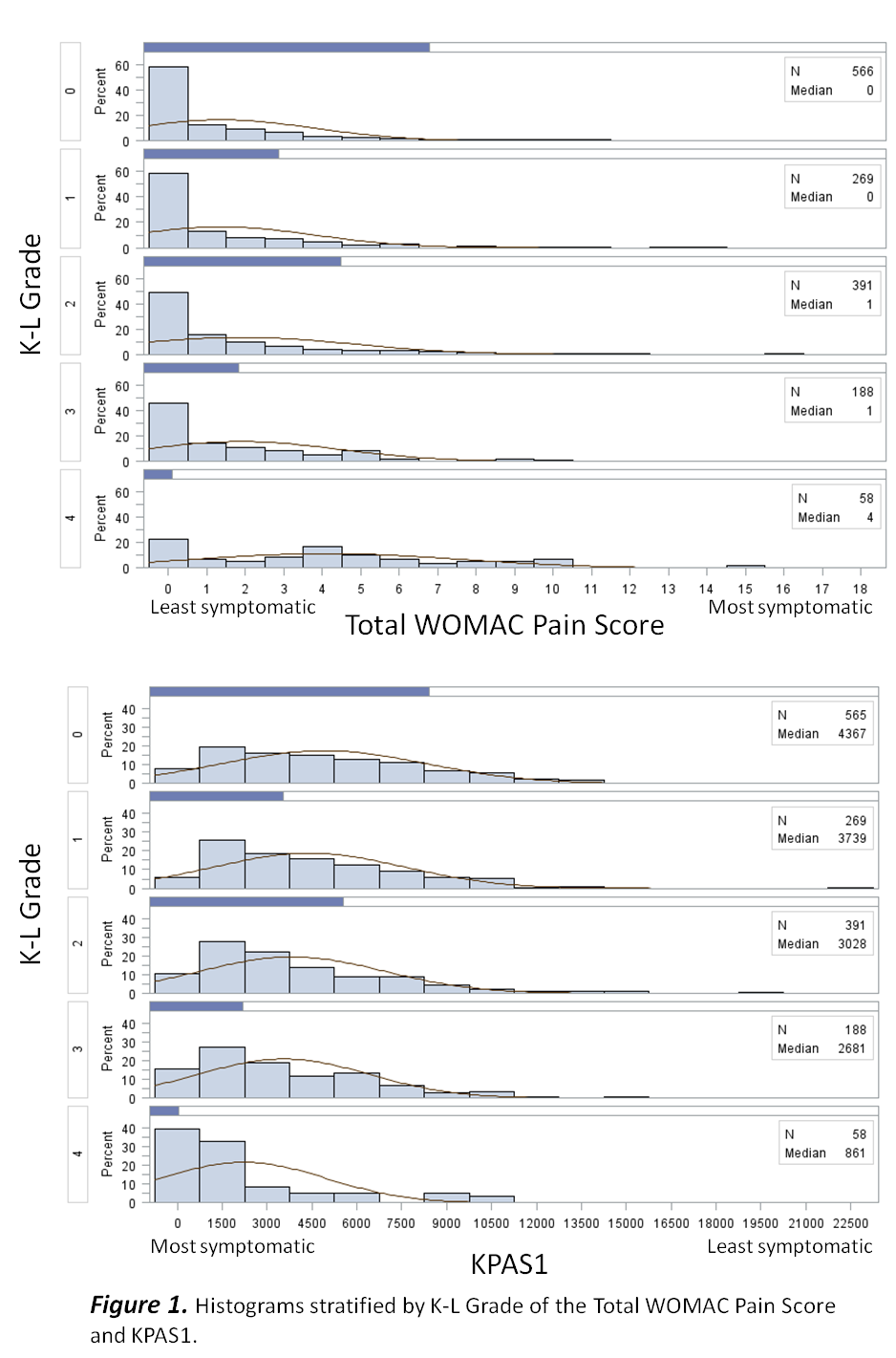Session Information
Session Type: Abstract Submissions (ACR)
Background/Purpose :
Symptom assessment in knee osteoarthritis (OA) is challenging. Knee pain does not always correlate well with radiographic severity, perhaps because people modify / avoid activities to reduce symptoms. Accelerometers / pedometers can inexpensively and easily quantify physical activity. We hypothesize that symptom assessment accounting for pain intensity in the context of physical activity will improve discrimination across OA radiographic severity levels.
Methods :
We studied Osteoarthritis Initiative (OAI) participants with ≥ 4 days accelerometer monitoring, knee-specific WOMAC pain data, and knee x-rays from the 48-month visit. Accelerometer data included average daily step count and average daily activity counts (i.e., weighted sum of activity frequency and intensity). Four composite knee pain and activity scores (KPAS) were calculated:
KPAS1 = daily step count/(Total WOMAC Pain Score + 1)
KPAS2 = daily activity count/(Total WOMAC Pain Score + 1)
KPAS3 = daily step count/(WOMAC Walking Pain Score + 1)
KPAS4 = daily activity count/(WOMAC Walking Pain Score + 1)
Lower KPAS values reflect greater symptoms, consistent with less activity and/or greater pain. X-rays were read for Kellgren and Lawrence (K-L) grade (0-4). For each participant, only right knee data were evaluated. Total WOMAC pain score, WOMAC walking pain score, accelerometer data, and KPAS scores were tested for normality, and score discrimination by K-L grades using stratified histograms, Kruskal – Wallis testing, and quantile regression analyses (excluding WOMAC walking pain) unadjusted and adjusted for age, sex and BMI.
Results : 1472 participants, mean age 64.9 (± 9.1), mean BMI 28.1 (± 4.8), 43% male, were included. No symptom score was normally distributed, with pain assessments being the most skewed.
|
Table 1. Kruskal – Wallis testing of symptom assessments across adjacent K-L grades. “X” denotes statistically significant differences.
|
||||||||
|
|
Symptom Assessments |
|||||||
|
K-L Grade Comparisons
|
WOMAC |
WOMAC Walk |
Step Count |
Activity Count |
KPAS1 |
KPAS2 |
KPAS3 |
KPAS4 |
|
0 v. 1
|
|
|
X
|
X
|
|
|
X
|
|
|
1 v. 2
|
X
|
X
|
|
|
X
|
X
|
X
|
X
|
|
2 v. 3
|
|
|
|
|
X
|
|
|
|
|
3 v. 4
|
X
|
X
|
|
|
X
|
X
|
X
|
X
|
|
Table 2. Quantile regression: Differences in median symptom scores across K-L grade groups. Referent group is K-L grade 0. For WOMAC score, higher score = greater symptoms. For all other scores, lower score = greater symptoms.
|
|||||||
|
Outcome |
Adjustment Factors |
Median Scores |
Differences in Median Scores from Referent Group |
P for trend |
|||
|
KL 0 (Referent) |
KL 1 |
KL 2 |
KL 3 |
KL 4 |
|||
|
WOMAC Total Pain |
Unadjusted |
0 |
0 |
1 |
1 |
4 |
p=.006
|
|
Adjusteda |
0 |
0 |
1 |
1 |
4 |
p<.001
|
|
|
Step count |
Unadjusted |
6253 |
-763* |
-774* |
-930* |
-1957* |
p<.001
|
|
Adjusteda |
18436 |
-286* |
-242 |
-222 |
-299 |
p=0.20 |
|
|
Activity count |
Unadjusted |
211358 |
-13429 |
-20681* |
-30746* |
-51700* |
p<.001
|
|
Adjusteda |
647624 |
-1920 |
732 |
7038 |
-3197 |
p=0.79 |
|
|
KPAS1 |
Unadjusted |
4367 |
-627* |
-1338* |
-1674* |
-3499* |
p<.001
|
|
Adjusteda |
11709 |
-387 |
-1116* |
-1245* |
-2912* |
p<.001
|
|
|
KPAS2 |
Unadjusted |
146556 |
-14023 |
-40866* |
-46057* |
-110077* |
p<.001
|
|
Adjusteda |
448042 |
-6880 |
-28642* |
-29064* |
-88068* |
p<.001
|
|
|
KPAS3 |
Unadjusted |
5560 |
-500* |
-1088* |
-1024* |
-2842* |
p<.001
|
|
Adjusteda |
16208 |
-179 |
-334 |
-271 |
-2226* |
p<.001
|
|
|
KPAS4 |
Unadjusted |
183218 |
-5603 |
-25181* |
-23770* |
-85471* |
p<.001
|
|
Adjusteda |
614784 |
-892 |
-7509 |
-5994 |
-56155* |
p=.003
|
|
|
a Adjusted for age, sex, and BMI * Statistical difference of group median compared to the referent (KL score of 0) median; p<0.05. |
|||||||
Conclusion :
Symptom assessments incorporating pain intensity and physical activity improved discrimination across radiographic OA severity. Pain better discriminates high disease severity while physical activity better distinguishes low severity. Relationships of KPAS measures with x-ray severity were robust to adjustment for traditional OA risk factors. To improve sensitivity, physical activity should be routinely assessed in studies of knee OA symptoms.
Disclosure:
G. H. Lo,
None;
T. E. McAlindon,
None;
G. A. Hawker,
None;
J. B. Driban,
None;
L. L. Price,
None;
J. Song,
None;
C. Eaton,
None;
M. C. Hochberg,
None;
R. D. Jackson,
None;
C. K. Kwoh,
None;
M. C. Nevitt,
None;
D. D. Dunlop,
None.
« Back to 2012 ACR/ARHP Annual Meeting
ACR Meeting Abstracts - https://acrabstracts.org/abstract/knee-osteoarthritis-symptom-assessments-that-combine-pain-and-physical-activity-are-superior-to-pain-alone/

